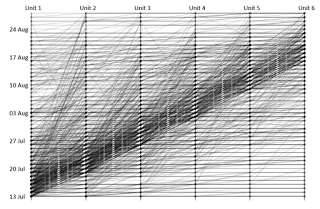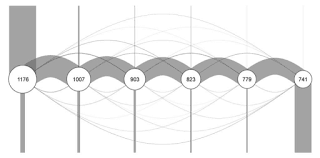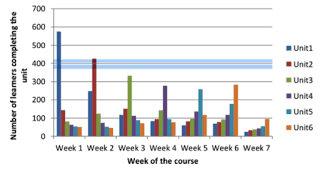8 Ways to Design Sticky MOOCs
The second part of Donald Clark’s analysis on improving MOOCs. In this article he provides 8 tips, backed up by research, on how to create a good MOOC.
This is a guest post from Donald Clark. It was originally published here.
Increasing persistence
Many of the arguments around course completion in MOOCs are, I have argued, category mistakes. Those mistakes are based on a false comparison with traditional higher education, semester-long, courses. We should not, of course, allow these arguments to distract us from making MOOCs better, in the sense of having more sticking power for participants. This is where things get interesting, because there have been some features of recent MOOCs that have caught my eye as providing higher levels of persistence among learners. The University of Derby’s “Dementia” MOOC, full title “Bridging the Dementia Divide: Supporting People Living with Dementia,” is a case in point.
1. Audience sensitive
MOOC learners are not undergraduates who expect a diet of lectures delivered synchronously over a semester. They are not at college and do not want to conform to institutional structures and timetables. It is unfortunate that many MOOC designers treat MOOC learners as if they were physically (and psychologically) at a university — they are not. They have jobs, kids, lives, and things to do. MOOC designers have to get out of their institutional thinking and realize that their audience often has a different set of intentions and needs. The new MOOCs need to be sensitive to learner needs.
2. Make all material available
To be sensitive to a variety of learners (see why course completion is a wrong-headed measure), the solution is to provide flexible approaches to learning within a MOOC, so that different learners can take different routes and approaches. Some may want to be part of a “cohort” of learners and move through the course with a diet of synchronous events, but many MOOC learners are far more likely to be driven by interest than by paper qualifications, so make the learning accessible from the start. Having materials available from day one allows learners to start later than others, proceed at their own rate and, importantly, catch up when they choose. This is in line with real learners in the real world, and is not focused on institutional learning.
3. Modular
The idea of a strictly linear diet of lectures and learning should also be eschewed, because different learners want different portions of the learning, and they want it at different times. A more modular approach, where modules are self-contained and can be taken in any order, is one tactic. Adaptive MOOCs, using AI software that guides learners through content on the basis of their needs, is another. In the Dementia MOOC, 6.16% of the learners didn’t start with Module 1.
This tracked data shows that some completed the whole course in one day, others did a couple of modules on one day, many did the modules in a different order, and some went through in a linear and measured fashion. Some even went backwards. The lesson here is that the course needs to be designed to cope with these different approaches to learning, in terms of order and time. This is better represented in this state diagram, showing the different strokes for different folks.
Each circle is a module containing the number of completions. Design for flexibility.
4. Shorter
MOOC learners don’t need the ten week semester structure. Some want much shorter and faster experiences, others want medium length, and some want longer courses. Higher education is based on an agricultural calendar, with set semesters that fit harvest and holiday patterns. The rest of the world does not work to this pre-industrial timetable. In the Derby Dementia MOOC, there is considerable variability on when people did their learning. Many learners took less that the six weeks, but that did not mean they spent less time on the course. Many others preferred concentrated bouts of learning that were longer than the regular once-per-week model that many MOOCs recommend or mandate. Other learners did the week-by-week learning. We have to understand that learning for MOOC audiences is taken erratically and is not always in line with the campus model. We need to design for this.
5. Structured and unstructured
I personally find the drip-feed, synchronous, moving through the course with a cohort style rather annoying and condescending. The evidence in the Dementia MOOC suggests that there was more learner activity in unsupported periods than in supported periods. This shows a considerable thirst for doing things at your own pace and convenience, rather than at the pace mandated by synchronous, supported courses. Nevertheless, this is not an argument for a wholly unstructured strategy. This MOOC attracted a diverse set of learners, and having both structured and unstructured approaches brought the entire range of learners along.
You can see that the learners who experienced the structured approach — which contained a live Monday announcement by the lead academic, a Friday wrap-up with a live webinar, and a help forum and email query service — was a sizeable group in any one week. Yet the other learners, those who learned without support, were also substantial in every week. This dual approach seems ideal, appealing to an entire range of learners with different needs and motivations.
6. Social not necessary
Many have little interest in social chat and being part of a consistent group or cohort. One of the great MOOC myths is that social participation is a necessary condition for learning and/or success. Far too much is made of “chat” in MOOCs, in terms of needs and quality. I’m not arguing for no social components in MOOCs; I’m only claiming that the evidence shows that such components are less important than the “social constructivist” orthodoxy in design would suggest. In essence, I’m saying it is desirable but not essential. To rely on this as the essential pedagogic technique, is, in my opinion, a mistake, and is to impose an ideology on learners that they do not want.
7. Adult content
In line with the idea of being sensitive to the needs of the learners, I’ve found too many rather earnest, talking heads from academics; especially the cosy chats, more suitable to the eighteen-year-old undergraduate than it is to the adult learner. You need to think about voice and tone, and avoid second-rate PhD research and an overly departmental approach to the content. I’m less interested in what your department is doing and far more interested in the important developments and findings at an international level in your field. MOOC learners have not chosen to come to your university: they’ve chosen to study a topic. We have to let up on being too specific in content, tone, and approach.
8. Badges
The dementia MOOC had six independent, self-contained sections, each with its own badge for completion; and each can be taken in any order, with an overall badge for completion. These partial rewards for partial completion proved valuable. It moves us away from the idea that certificates of completion are the way we should judge MOOC participation. In the Dementia MOOC, 1201 learners were rewarded with badges compared to 527 receiving completion certificates.
Conclusion
The researchers at Derby used a very interesting phrase in their conclusion. They said that “a certain amount of chaos may have to be embraced.” This is right. Too many MOOCs are over-structured, too linear, and too like traditional university courses. They need to loosen up and deliver what these newer, more diverse audiences want. Of course, this also means being careful about what is being achieved here. Quality within these looser structures, and in each of these individual modules, must be maintained.
Bibiography
Clark, D. (2013). MOOCs: Adoption curve explains a lot. http://donaldclarkplanb.blogspot.co.uk/2013/12/moocs-adoption-curve-explains-lot.html
Hayes, S. (2015). MOOCs and Quality: A review of the recent literature. Retrieved 5 October 2015, from http://www.qaa.ac.uk/en/Publications/Documents/MOOCs-and- Quality-Literature-Review-15.pdf
Ho, A. D., Reich, J., Nesterko, S., Seaton, D. T., Mullaney, T., Waldo, J. & Chuang, I. (2014). HarvardX and MITx: The first year of open online courses. Re- trieved 22 September 2015, from http://papers.ssrn.com/sol3/papers.cfm?abstract_id=2381263
Leach, M. Hadi, S. Bostock, (2016) A. Supporting Diverse Learner Goals through Modular Design and Micro-Learning. Presentation at European MOOCs Stakeholder Summ
Hadi, S. Gagen P. New model formeasuring MOOCs completion rates. Presentation at European MOOCs stakeholder summit.
You can enroll for the University of Derby Dementia MOOC here.
You can find more MOOC stuff here.
Donald Clark is an EdTech entrepreneur. He was CEO and one of the original founders of Epic Group plc, which established itself as the leading company in the UK online learning market. It was floated on the stock market in 1996 and sold in 2005. He is an award winning speaker at national and international conferences, and he has delivered keynotes in Europe, the United States, Africa, Australia, and the Middle and Far East.








